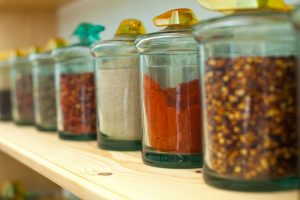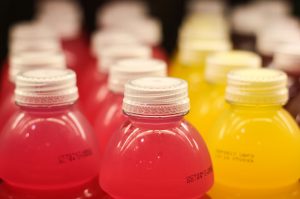There seem to be quite a few misconceptions regarding “natural flavors,” “artificial flavors,” and “spices” on food labels. I’ve heard arguments that “they can contain anything” to claims that flavors, artificial or natural, can contain toxic chemicals. So, what’s the truth? Can food companies hide whatever ingredients they want under the heading “natural flavors?” Can they lump everything from MSG to preservatives into the ingredient “spices” on the ingredient declaration? Well, not exactly. Here are the facts and fallacies regarding these sweeping claims about flavors and spices.
First, the U.S. Food and Drug Administration has specific regulations for what can be included in “natural flavors,” “artificial flavors,” and “spices.” So, it’s not true that food manufacturers can hide whatever ingredients they want under those headings. One of the most common misconceptions is that monosodium glutamate (MSG) can be listed under “spices,” but that’s not true. If MSG is added to a food, it has to be listed separately on the ingredient declaration.
Here are the FDA definitions for each:
(1) The term artificial flavor or artificial flavoring means any substance, the function of which is to impart flavor, which is not derived from a spice, fruit or fruit juice, vegetable or vegetable juice, edible yeast, herb, bark, bud, root, leaf or similar plant material, meat, fish, poultry, eggs, dairy products, or fermentation products thereof.
(2) The term spice means any aromatic vegetable substance in the whole, broken, or ground form, except for those substances which have been traditionally regarded as foods, such as onions, garlic and celery; whose significant function in food is seasoning rather than nutritional; that is true to name; and from which no portion of any volatile oil or other flavoring principle has been removed.
Paprika, turmeric, and saffron or other spices which are also colors, shall be declared as “spice and coloring” unless declared by their common or usual name.
(3) The term natural flavor or natural flavoring means the essential oil, oleoresin, essence or extractive, protein hydrolysate, distillate, or any product of roasting, heating or enzymolysis, which contains the flavoring constituents derived from a spice, fruit or fruit juice, vegetable or vegetable juice, edible yeast, herb, bark, bud, root, leaf or similar plant material, meat, seafood, poultry, eggs, dairy products, or fermentation products thereof, whose significant function in food is flavoring rather than nutritional.

Another claim I hear quite often is that natural flavors are the same as artificial flavors, and that’s somewhat true. Keep in mind that whether a chemical is natural or synthetic tells you precisely nothing about it’s safety, so the distinction between “natural” and “artificial” means nothing in terms of safety or nutrition.
Flavors, including those naturally present in foods, are made up of chemical compounds, as is everything we consume. For example, as many as 250 taste and aroma compounds have been detected in vanilla extract. There are many different chemical compounds that can be derived from natural sources that can also be chemically synthesized. Vanillin is just one example. It’s the same chemical compound whether naturally or artificially derived, but can only be included in “natural flavors” if derived from natural sources.
Many nature-identical artificial flavors are actually available in higher purity than their natural counterparts and can be obtained with less damage to the environment. In addition, both natural and artificial flavors can contain additional non-flavor ingredients that preserve, carry, and stabilize the flavors. The origin of these ingredients can be both natural and artificial.
Now that we understand what they are, let’s talk about safety. Flavors are produced in a controlled laboratory setting and undergo rigorous quality control at every stage. Flavorists or flavor chemists are specifically trained to create flavors. They must complete a seven-year apprenticeship (following university education) before becoming certified by the Society of Flavor Chemists. They must follow a stringent set of safety guidelines and comply with all of the same Food and Drug Administration and Department of Agriculture rules developed for food production.

In addition, the Flavor Extract Manufacturers Association (FEMA), which is composed of a panel of scientific and medical experts (representing fields including chemistry, toxicology, pharmacology, medicine, pathology, and statistics) has compiled a list of thoroughly studied flavor compounds that are “generally recognized as safe (GRAS).” Any new flavor substances that are not on the list require extensive safety testing and approval before they can be used in consumer products.
The FDA does not require companies to disclose the individual ingredients that make up these natural or artificial flavors. Just like there can be hundreds of chemical compounds that make up the flavor in any given fruit or vegetable (recall that vanilla extract contains as many as 250 compounds), there can be just as many chemical compounds in a single flavor. Not only would it not be very helpful to the consumer to list out all of the compounds, but it wouldn’t fit on most food labels either. In addition, it serves to protect the proprietary formula of the flavor.
This goes for spices as well. Companies can decide to list out all of the spices individually on an ingredient declaration or they can list them as “spices” to make the ingredient declaration more compact and/or to protect the proprietary formula of the spice blend. If a flavor or spice blend contains any of the top eight allergens (milk, eggs, fish, shellfish, tree nuts, peanuts, wheat, and soybean), they have to be declared in plain English either in the ingredient declaration or in the separate “Contains” statement. If you have a rare allergy to something other than these top eight allergens, you can always call the food company and inquire if their flavor or spice blend is free from the specific allergen of concern.
Both flavors and spices serve to make foods taste better and just overall more enjoyable. Just think of all of your favorite flavor combinations that would have never existed without the work of flavor chemists!
Food Science Babe is the pseudonym of an agvocate and writer who focuses specifically on the science behind our food. She has a degree in chemical engineering and has worked in the food industry for more than decade, both in the conventional and in the natural/organic sectors.



